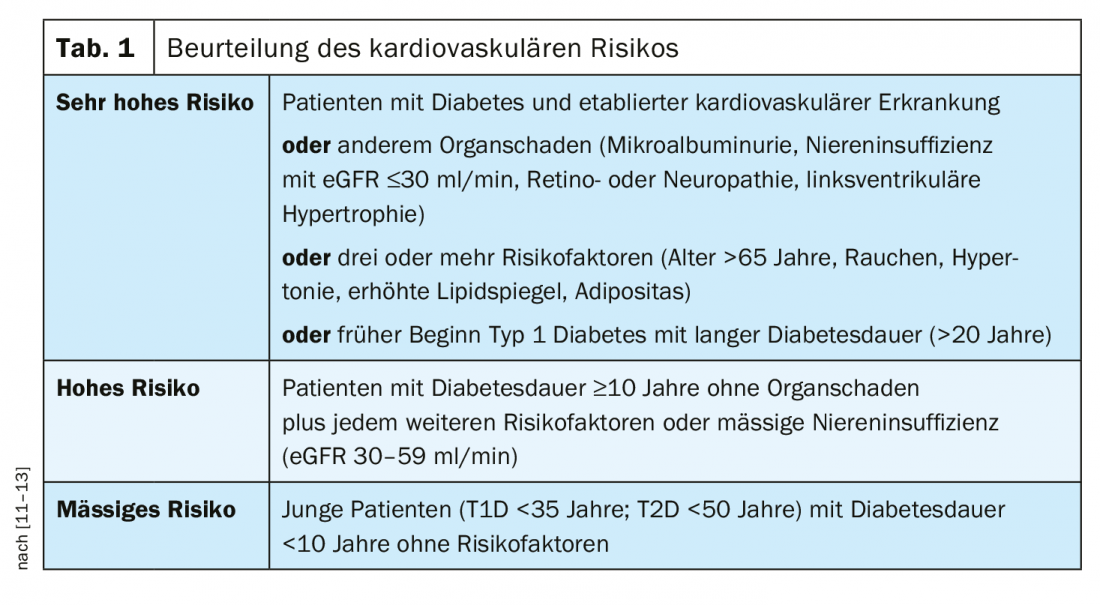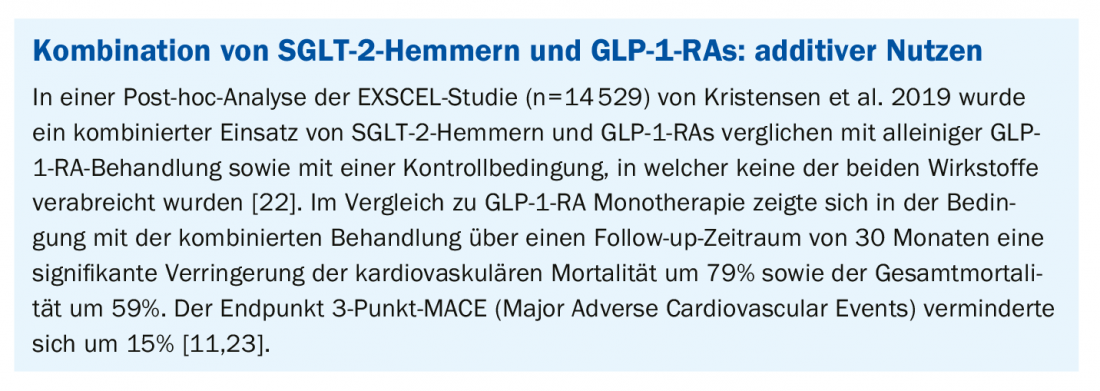When prescribing antidiabetic therapy, other criteria are relevant today in addition to blood glucose control. The cardiac benefit of SGLT2 inhibitors and GLP1 analogues has been incorporated into international guidelines and also into the 2020 revised version of the recommendations of the Swiss Society of Endocrinology and Diabetology.
A significant increase in the prevalence numbers of diabetic diseases is reported worldwide [1,2]. In 2019, the International Diabetes Federation (IDF) recorded 463 million adults with diabetes [3]. For a long time, clinical trials for the treatment of type 2 diabetes (T2D) only considered measurements of surrogate parameters such as blood glucose and HbA1c. This has changed, with professional societies and regulatory authorities increasingly recognizing that the benefit of diabetes therapies is not limited to the normalization of laboratory parameters, but should essentially achieve reductions in morbidity and mortality. This led to a paradigm shift in diabetes treatment research, which was reflected, among other things, in the implementation of the large cardiovascular outcomes trials (CVOTs). In the EMPA-REG study, the SGLT-2 inhibitor empaglifozin (Jardiance®) was shown to result in significant reductions in 3-point MACE (14%), cardiovascular mortality (38%), hospitalization for heart failure (35%), and all-cause mortality (32%) compared with placebo [4]. According to CREDENCE, the SGLT-2 inhibitor canagliflozin achieves similar results [5]. Regarding GLP-1 RA, the LEADER endpoint study resulted in evidence of additional cardiovascular benefit with reductions in terms of 3-point MACE (13%), cardiovascular mortality (22%), and all-cause mortality (15%) [6]. The cardiovascular benefit of SGLT2 inhibitors and GLP1 analogues has been considered in recent guidelines from various European and North American professional societies [7–10].
Heart failure and nephroprotection in focus
Optimally tailoring treatment to the individual patient’s condition can be complex due to the heterogeneity of T2D and any comorbidities. The Swiss recommendations for the treatment of T2D provide important decision-making information for general practitioners to choose the most appropriate therapy [11]. The 2020 updates include consideration of recent CVOTs, which aimed to demonstrate the safety of anti-diabetic medications in a high-risk population with existing cardiovascular disease and with or without chronic kidney disease [11]. According to the latest ESC/EASD guidelines, the classification as being at high risk applies not only to patients with existing cardiovascular disease, but also to those with three or more additional risk factors, which is common in most T2D patients, especially when microvascular complications are present (nephropathy, retinopathy, or neuropathy) [12,13] (Tab. 1). Approved drug classes that have been shown to reduce cardiovascular events, cardiovascular mortality, and all-cause mortality, and have demonstrated nephroprotective effects, are currently limited to SGLT-2 inhibitors [4,5,14,15] and GLP-1 RAs [16–19,22]. SGLT-2 inhibitors are also suitable for the treatment of heart failure, according to current evidence.

How do SGLT-2 inhibitors differ from GLP-1 RAs?
There is now general consensus that SGLT-2 inhibitors and GLP-1 RAs have significant beneficial effects on cardiovascular disease, cardiovascular mortality, and all-cause mortality. Moreover, they delay the development of chronic kidney disease and heart failure in patients with diabetes. A direct comparison of the two drug classes has not yet been performed. However, data from several studies indicate that GLP-1 RAs have an impact on the occurrence of microalbuminuria and macroalbuminuria. SGLT-2 inhibitors result in a 40% to 50% reduction in eGFR and delayed progression of kidney disease [11]. Both empagliflozin (SGLT-2 inhibitor) and liraglutide (GLP-1-RA) reduce cardiovascular and all-cause mortality [4,18]. A reduction in stroke incidence has so far only been demonstrated for GLP-1 RAs [14-19]. Cardiovascular endpoint studies of the combined use of these two drug classes have not been performed. However, there are data showing that a combination of the two classes has additive effects in terms of reducing HbA1c, weight, and blood pressure [20–22]. This was shown, among other things, in post-hoc analyses of the EXSCEL study (box) [11,22,23].

Choice of therapy in the context of the overall situation
The following is an overview of factors that should be included in antidiabetic treatment decisions, according to SGED recommendations, to achieve the best possible outcomes and reduce the risk of cardio-renal complications [11]:
Consider administration of insulin: Whether a diabetic patient needs insulin is a key question. According to SGED recommendations, insulin administration is never wrong in the following cases: too high HbA1c level (>10%); no metabolic syndrome, no visceral obesity, no typical dyslipidemia (low HDL cholesterol and high triglycerides); clinical symptoms of insulin deficiency (weight loss, polyuria and polydipsia). In a small minority of patients, the presence of type 1 diabetes or pancreatic disease (chronic pancreatitis) is possible.
Reduction of cardiovascular load: this is crucial. According to SGED recommendations, an early combination of SGLT-2 inhibitors or GLP-1 RAs with metformin should be performed in accordance with the mentioned CVOTs.
SGLT-2 inhibitors or GLP-1-RAs: As mentioned, these substance classes have different mechanisms of action, which have not yet been fully clarified. A common feature of drugs in both drug classes is the demonstrated reduction in cardiovascular events, mortality, and reduced progression of nephropathy. The SGED recommends a combined use of SGLT-2 inhibitors and GLP-1 RAs, although cost coverage is an issue to be clarified.
Control of HbA1c: Lowering HbA1c to a target value of less than 7% is important for reducing the risk of microvascular and macrovascular complications. There is no lower limit for the HbA1c value if no drug classes are used that can cause hypoglycemia (insulin and/or sulfonylurea). If this is the case, the target HbA1c range is 6-7%.
Consider patient preferences: The efficacy, benefits, and adverse effects of the available antidiabetic agents should be discussed with the patient to make a shared decision.
BMI >28 is an indication for the use of GLP-1-RA: GLP-1-RAs can be used together with insulin, preferably in a fixed combination.
Compliance: the patient should receive instructions on the rules regarding sick days. This includes going to the hospital if vomiting, diarrhea or acute signs of illness occur. If surgery is planned, discontinue SGLT-2 inhibitors and metformin and replace with insulin if necessary. This simple measure can prevent the rare cases of diabetic ketoacidosis and lactic acidosis.
Basal insulin: Current evidence suggests that insulin degludec and insulin glargine U300 best prevent hypoglycemia – especially nocturnal hypoglycemia – followed by insulin glargine U100 and insulin detemir, and finally by NPH insulin.
Renal function: most drugs cannot be prescribed if eGFR is less than 30 ml/min.
Heart failure: reduction of mortality and cardiovascular events should always be kept in mind as treatment goals. Heart failure with preserved ejection fraction (HFPEF) affects approximately ¾ of all cases in T2D and is characterized by a left ventricular ejection fraction >40%. Approximately ¼ of patients have heart failure with reduced ejection fraction (HFREF).
Literature:
- Ingelfinger JR, Jarcho JA : Increase in the incidence of diabetes and its implication. N Engl J Med 2017; 376: 1473-1474.
- NCD Risk Factor Collaboration: Worldwide trends in diabetes since 1980: a pooled analysis of 751 population-based studies with 4.4 million participants. Lancet 2016; 387: 1513-1530
- International Diabetes Federation, IDF Diabetes Atlas 2019, 9th edn. www.diabetesatlas.org
- Zinman B, et al: Empagliflozin, Cardiovascular Outcomes, and Mortality in Type 2 Diabetes. N Engl J Med 2015; 373(22): 2117-2128.
- Neal B, et al: Canagliflozin and Cardiovascular and Renal Events in Type 2 Diabetes. N Engl J Med. 2017; 377(7): 644-657.
- Marso SP, et al: N Engl J Med 2016; 375: 311-322. DOI:10.1056/NEJMoa1603827.
- EASD: European Association for the Study of Diabetes, www.easd.org
- ADA: American Diabetes Association, www.diabetes.org
- SGED: Swiss Society of Endocrinology and Diabetes, www.sgedssed.ch
- ESC: European Societry of Cardiology, www.escardio.org
- SGED: Recommendations of the Swiss Society of Endocrinology and Diabetology (SGED/SSED) for the Treatment of Type 2 Diabetes Mellitus, 2020, www.sgedssed.ch/diabetologie/sged-empfehlungen-diabetologie
- Mach F, et al: 2019 ESC/EAS Guidelines for the management of dyslipidaemias: lipid modification to reduce cardiovascular risk. Eur Heart J 2019.
- Cosentino F, et al: 2019 ESC Guidelines on diabetes, pre-diabetes, and cardiovascular diseases developed in collaboration with the EASD. Eur Heart J 2019.
- Wiviott SD, et al: Dapagliflozin and Cardiovascular Outcomes in Type 2 Diabetes. N Engl J Med 2019; 380(4): 347-357.
- Perkovic V, et al: Canagliflozin and Renal Outcomes in Type 2 Diabetes and Nephropathy. N Engl J Med 2019; 380(24): 2295-2306.
- Mann JFE, et al: Liraglutide and Renal Outcomes in Type 2 Diabetes. N Engl J Med 2017; 377(9): 839-848.
- Marso SP, et al: Semaglutide and Cardiovascular Outcomes in Patients with Type 2 Diabetes. N Engl J Med 2016; 375(19): 1834-1844.
- Marso SP, et al: Liraglutide and Cardiovascular Outcomes in Type 2 Diabetes. N Engl J Med 2016; 375(4): 311-322.
- Gerstein HC, et al: Dulaglutide and cardiovascular outcomes in type 2 diabetes (REWIND): a double-blind, randomised placebo-controlled trial. Lancet 2019; 394(10193): 121-130.
- van Baar MJB, et al: SGLT2 Inhibitors in Combination Therapy: From Mechanisms to Clinical Considerations in Type 2 Diabetes Management. Diabetes Care 2018; 41(8): 1543-1556.
- Zinman B, et al: Semaglutide once weekly as add-on to SGLT-2 inhibitor therapy in type 2 diabetes (SUSTAIN 9): a randomised, placebo-controlled trial. Lancet Diabetes Endocrinol 2019; 7(5): 356-367.
- Kristensen SL, et al: Cardiovascular, mortality, and kidney outcomes with GLP-1 receptor agonists in patients with type 2 diabetes: a systematic review and meta-analysis of cardiovascular outcome trials. Lancet Diabetes Endocrinol 2019; 7(10): 776-785.
- Clegg L, et al: Poster on EASD 2019.
HAUSARZT PRAXIS 2020; 15(5): 32-34











